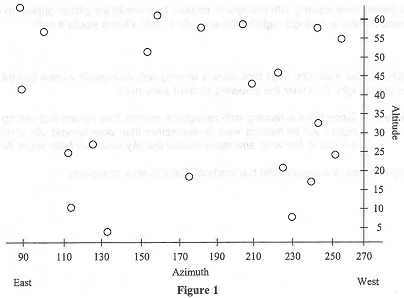Assignment Task: Observing Retrograde Motion
One of the most difficult parts of constructing an accurate model for planetary motions is that planets seem to wander among the stars. During their normal (or pro-grade) motion, planets appear to move from west to east over many consecutive nights as seen against the background stars. However, they occasionally (and predictably) appear to reverse direction and move east to west over consecutive nights as seen against the background stars. This backward motion is called retrograde motion.
1) Given the data in Table 1, plot the motion of the mystery planet on the graph provided in Figure 1 (record dates next to each position you plot). Then, draw a smooth line (or curve), using your data points, to illustrate the path of the planet through the sky.
Table 1: Mystery Planet Positions
|
Date of Observation
|
Azimuth (horizontal direction)
|
Altitude (vertical direction)
|
|
May-01
|
240
|
45
|
|
May-15
|
210
|
50
|
|
Jun-01
|
170
|
50
|
|
Jun-15
|
150
|
45
|
|
Jul-01
|
170
|
40
|
|
Jul-15
|
180
|
45
|
|
Aug-01
|
140
|
50
|
|
Aug-15
|
120
|
55
|

Do you fear of not being capable to wrap up your assignments and homework within the given time stipulation? Then, hire our professional Retrograde Motion Assignment Help service to score top-notch grades, without any problem.
Tags: Retrograde Motion Assignment Help, Retrograde Motion Homework Help, Retrograde Motion Coursework, Retrograde Motion Solved Assignments, Planetary Motions Assignment Help, Planetary Motions Homework Help